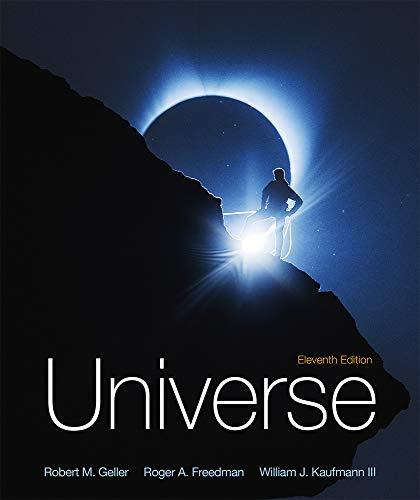
(a)
The kinetic energy of an asteroid having radius
(a)
Answer to Problem 12Q
Solution:
The kinetic energy of the asteroid is found out to be
Explanation of Solution
Given data:
The velocity of the asteroid hitting the Earth is
The radius of the asteroid is
The density of the asteroid is
Formula used:
The mass of the asteroid can be calculated by the following expression:
Here,
The expression for the volume of a sphere is:
Here,
Conversion formula from kilometer to meter is:
1 km = 1000 m
The kinetic energy is calculated by the below expression:
Here,
Explanation:
Recall the expression for calculating the volume.
Substitute 1 km for
Recall the expression of mass.
Substitute
The mass of asteroid is
Recall the expression for the kinetic energy.
Substitute
Conclusion:
Thus, the kinetic energy of the asteroid is found out to be
(b)
The comparison between the energy released by the impact of asteroid mentioned in sub-part (a) to the energy released by a 20-kiloton nuclear weapon, which was similar to the nuclear weapon dropped on Hiroshima.
(b)
Answer to Problem 12Q
Solution:
The energy released during nuclear destruction is 40 times smaller than the energy released during the asteroid strike.
Explanation of Solution
Given data:
The energy released by the nuclear weapon is 20-kilotons.
Formula used:
1 kiloton of TNT emits
The expression of energy released in joules is:
Explanation:
From sub-part (a), the value of kinetic energy of the asteroid is
Recall the expression of energy released in joules.
Substitute
Refer to the value of energy released by the impact of an asteroid that is
The energy released in nuclear attack is
Taking the ratio of both the above energies,
Conclusion:
Therefore, the kinetic energy of the asteroid striking the Earth’s surface is
Want to see more full solutions like this?
Chapter 7 Solutions
Universe
- 3. If the force of gravity stopped acting on the planets in our solar system, what would happen? a) They would spiral slowly towards the sun. b) They would continue in straight lines tangent to their orbits. c) They would continue to orbit the sun. d) They would fly straight away from the sun. e) They would spiral slowly away from the sun. 4. 1 The free-body diagram of a wagon being pulled along a horizontal surface is best represented by A F N B C 0 Ꭰ FN E a) A b) B c) C app app The app 10 app d) e) ס ח D E 10 apparrow_forwardPls help ASAParrow_forwardPls help asaparrow_forward
- Pls help asaparrow_forwardThe acceleration of an object sliding along a frictionless ramp is inclined at an angle 0 is 9. a) g tano b) g cose c) g sino 10. d) g e) zero A 1.5 kg cart is pulled with a force of 7.3 N at an angle of 40° above the horizontal. If a kinetic friction force of 3.2 N acts against the motion, the cart's acceleration along the horizontal surface will be a) 5.0 m/s² b) 1.6 m/s² c) 2.4 m/s² 11. d) 1.0 m/s² e) 2.7 m/s² What is the net force acting on an object with a mass of 10 kg moving at a constant velocity of 10 m/s [North]? a) 100 N [North] b) 100 N [South] 10 N [North} d) 10 N [South] e) None of these.arrow_forwardModified True/False - indicate whether the sentence or statement is true or false. If the statement is false, correct the statement to make it true. 12. An object in uniform circular motion has a constant velocity while experiencing centripetal acceleration. 13. An object travelling in uniform circular motion experiences an outward centrifugal force that tends to pull the object out of the circular path. 14. An object with less inertia can resist changes in motion more than an object with more inertia. 15. For an object sliding on a horizontal surface with a horizontal applied force, the frictional force will always increase as the applied force increases.arrow_forward
 Physics for Scientists and Engineers: Foundations...PhysicsISBN:9781133939146Author:Katz, Debora M.Publisher:Cengage Learning
Physics for Scientists and Engineers: Foundations...PhysicsISBN:9781133939146Author:Katz, Debora M.Publisher:Cengage Learning
 Foundations of Astronomy (MindTap Course List)PhysicsISBN:9781337399920Author:Michael A. Seeds, Dana BackmanPublisher:Cengage Learning
Foundations of Astronomy (MindTap Course List)PhysicsISBN:9781337399920Author:Michael A. Seeds, Dana BackmanPublisher:Cengage Learning Stars and Galaxies (MindTap Course List)PhysicsISBN:9781337399944Author:Michael A. SeedsPublisher:Cengage Learning
Stars and Galaxies (MindTap Course List)PhysicsISBN:9781337399944Author:Michael A. SeedsPublisher:Cengage Learning
 Stars and GalaxiesPhysicsISBN:9781305120785Author:Michael A. Seeds, Dana BackmanPublisher:Cengage Learning
Stars and GalaxiesPhysicsISBN:9781305120785Author:Michael A. Seeds, Dana BackmanPublisher:Cengage Learning





